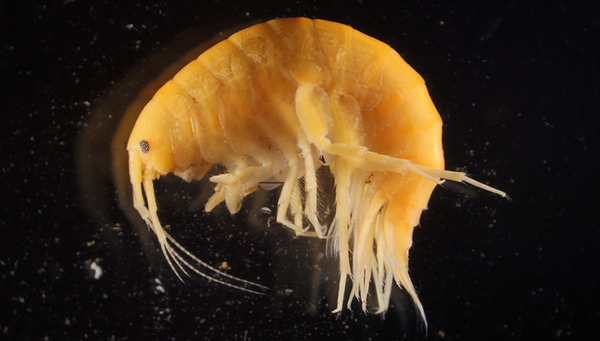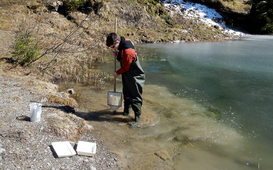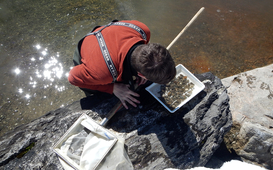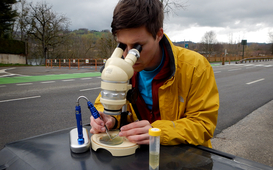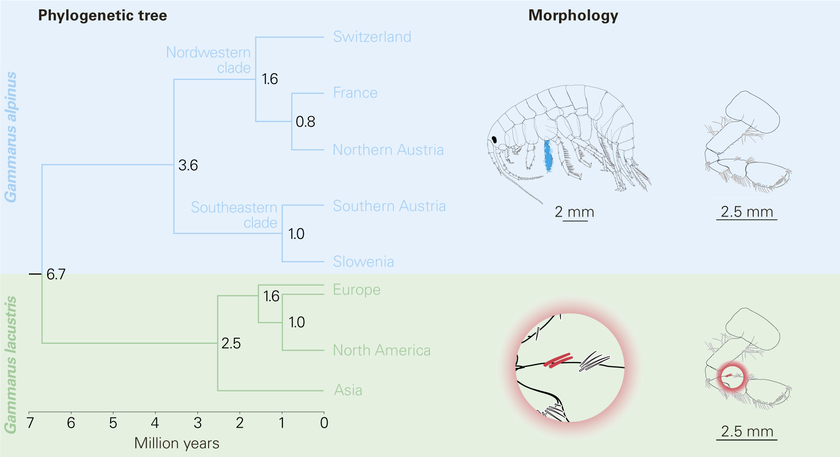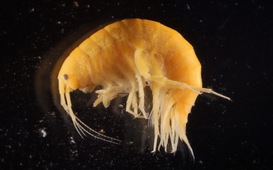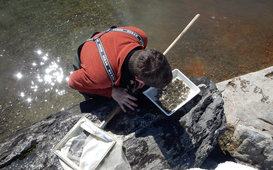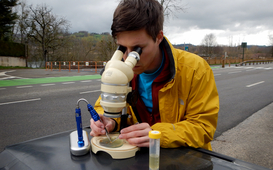Archive detail
Newly described amphipod species already under threat
September 8, 2016 |
While many biologists probably dream of discovering a new plant or animal species, the discovery made by Roman Alther and Florian Altermatt of the Aquatic Ecology department at Eawag was more of an incidental result of their research on a supposedly known and widely distributed species. For his doctoral dissertation at Eawag and Zurich University, Alther is preparing an overview of the distribution and diversity of amphipods in Switzerland. The order of crustaceans known as Amphipoda serves important functions in freshwater ecosystems. Amphipods break down organic matter and provide a food resource for fish. In addition, they are used as indicator species in the assessment of water quality. But according to Altermatt, who is supervising the dissertation: “Surprisingly little is known about amphipods, despite their ecological importance. As yet, no definitive species lists or distribution maps are available for Switzerland, let alone an overview of how the various species differ genetically, morphologically and functionally.” Altermatt estimates that Switzerland is home to between 30 and 40 amphipod species.
Alpine populations – a distinct species
One of the amphipods whose distribution Alther has investigated is Gammarus lacustris – a cosmopolitan species, found in Asia and America as well as Europe. Wishing to find out how closely alpine gammarid populations are related, Alther collected samples from lakes in France, Italy, Austria and Switzerland (Fig. 2). These were complemented with specimens from the collections of a number of natural history museums, together with published genetic data. In the laboratory, the individual gene sequences were compared and, with the aid of a computer, a phylogenetic tree was constructed. Alther explains: “To our surprise, we found that the alpine populations form a completely separate branch, differing from the non-alpine populations of Gammarus lacustris. This clear genetic differentiation provides strong evidence that the alpine gammarids represent a distinct species.”
Fig. 2: In the Lac des Plagnes (Haute-Savoie, France), Roman Alther uses a kicknet to collect macroinvertebrates. On the lakeshore, gammarids are picked out and a microscope is used for initial identification. (Photos: Barbara Weigelt)
To determine whether alpine gammarids also differ morphologically from Gammarus lacustris, the biologists sought the assistance of an experienced taxonomist from Slovenia. “Specialists like this are indispensable for our research,” says Altermatt, “but unfortunately they’re increasingly rare in this country.” Guided by the Slovenian expert, the biologists dissected the gammarid specimens (around two centimetres long), comparing the antennae, mouthparts and various other appendages – and made an interesting discovery. Alther explains: “The most noticeable feature distinguishing the alpine gammarid is that, on its second pair of feeding limbs, it only has one group of bristles. In Gammarus lacustris, there are two.” On the basis of the genetic and morphological differences (Fig. 3), the biologists assigned the alpine populations to a new species, which they named Gammarus alpinus.
Scientists who describe a new species have to follow certain rules. The first description must appear in a scientific publication, indicating the relevant (“diagnostic”) characteristics which enable the new species to be identified and distinguished from related species. Alther and Altermatt’s description has been published in the renowned Zoological Journal of the Linnean Society. The description must be based on a type specimen, known as the holotype, deposited in a public scientific collection. In the case of Gammarus alpinus, the holotype is a specimen from Lake St Moritz, held by the Lausanne Museum of Zoology. Additional specimens are deposited in Eawag’s collection at Dübendorf. The new species name has been recorded in the official registry of zoological nomenclature (ZooBank).
Speciation promoted by glaciation
Analysis of the phylogenetic tree suggests that Gammarus alpinus began to develop as a separate species around seven million years ago. According to the authors, the speciation process was probably promoted by glaciation of the Alps during the subsequent Pleistocene epoch. The ice sheets served as barriers to reproduction, isolating the alpine populations from other gammarid populations and preventing gene flow. The authors believe that, during glacial maxima, Gammarus alpinus withdrew to a southern refugium, spreading northwards again as the glaciers retreated. This explains why the species now occurs almost exclusively in areas that drain into the Mediterranean or the Black Sea and are absent in most of the Rhine drainage basin (Fig. 4).
The distribution of Gammarus alpinus appears to be restricted to the Alps. As Altermatt points out, “This means the Alpine countries have a special responsibility for the conservation of this endemic species.” Certain alpine lakes are exposed to nutrient inputs associated with agricultural land use, and gammarid populations may be adversely affected as a result. In the future, climate change could also pose an increasing threat to Gammarus alpinus, which is adapted to cold conditions.
Fig. 3: According to the genetic data, the evolutionary paths of Gammarus alpinus and Gammarus lacustris diverged 6.7 million years ago. Gammarus alpinus subsequently split into a northwestern and a southeastern clade. Morphologically, Gammarus alpinus can only be identified under the microscope: the penultimate segment (carpopodite) of the second pair of feeding limbs (gnathopods) only has one group of bristles (setae) along the anterior margin (top right), while Gammarus lacustris has two groups of setae (bottom right).
Drawings: Vid Švara
Threatened by invasive species
At present, however, the greatest threat comes from invasive species: “The situation is particularly acute in Lake Constance,” says Altermatt, “where Gammarus alpinus populations are being outcompeted by Dikerogammarus villosus – the so-called killer shrimp which has spread from the Black Sea region.” While alpine lakes have not yet been invaded by alien species, there is a certain risk that such species could be unwittingly introduced by tourists or via diving or fishing equipment. There is thus a need for greater awareness of this issue in mountain regions: as far as possible, alpine lakes should continue to serve as undisturbed refugia for endemic species such as Gammarus alpinus.
Fig. 4: The lakes where Gammarus alpinus occurs lie almost exclusively in areas draining into the Mediterranean or the Black Sea. Over 450,000 years ago, Lake Constance and the predecessor of the alpine Rhine – now part of the North Sea catchment – still drained into the Danube and thence to the Black Sea.

